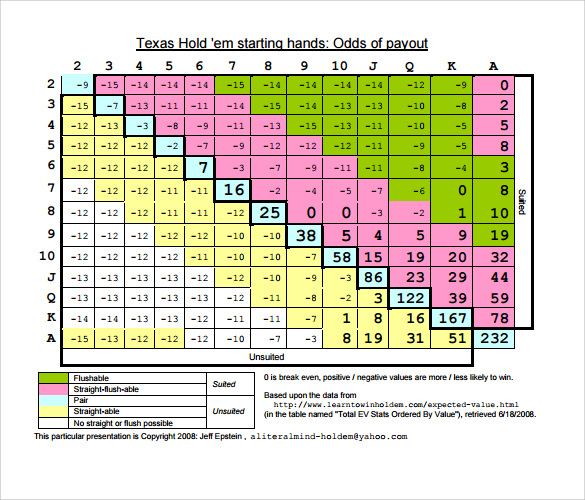Once the flop has been dealt in Texas Hold'em, you'll be able to count your outs and know how likely it is your hand will improve. That will tell you whether you should stay in the hand or fold.
You can figure out your outs and odds for any hand, but here is a quick and dirty list of the most common scenarios:
Your Texas Hold'em poker odds are given below for hitting a draw by the river with a given number of outs after the flop and turn, and examples of draws with specified numbers of poker outs given. Example: if you hold 22 and the flop does not contain a 2, the odds of hitting a 2 on the turn is 22:1 (4%). Pocket jacks is known as a big danger hand in Texas Hold'em. It may look good, but the chances of a higher card turning up on the flop is 52%, giving your ‘fish-hooks' less than half a chance of survival.
Texas Hold'em Cheat SheetOdds Based on Outs after the Flop
In Texas Hold'em a hand where aces, kings and queens pair up preflop is very rare. At a 9 player table this scenario unfolds roughly every 17,000 hands. The odds are 1:16,830 and the probability is 0.006%. Queens does happen every now and then, for example during this hand at the Bike. The following tables provide various probabilities and odds for many of the common events in a game of Texas hold 'em. Odds% Example Win% 330-to-1 0.30% JJ v 77 80% v 20%.
Want to make a time schedule in Microsoft Excel partitioned into perfectly regimented 15-minute intervals? It's easy, provided you know how to go about it. And in this Excel tutorial from ExcelIsFun, the 543rd installment in their series of Excel magic tricks, you'll learn how to do just that using the Fill Handle. For a complete walkthrough, watch this Microsoft Office how-to. You can apply the following formulas to add time with hours/minutes/seconds increments in Excel. Enter the start time into a blank cell (says A1), then select the following blank cells which you need to fill with increment time. Here I select A2:A15. Create a formula for entering a series of incremental times in Excel by Mary Richardson in Software on February 28, 2006, 6:50 AM PST You can have Excel enter time increments in your worksheet. Add time in excel. Select the cell where the slot time is to be decided. Put the formula as =TIME (HOUR (CELL CONTAINING THE TIME),CEILING.MATH (MINUTE (CELL CONTAINING THE TIME),15,0),0) For our example, the time is kept in E17 so the formula is =TIME (HOUR (E17),CEILING.MATH (MINUTE (E17),15,0),0).
Texas Holdem Poker Odds Calculator
Phaser js slot machine. If after the flop, you have:
Two outs: Your odds are 11 to 1 (about 8.5 percent)
A common scenario would be when you have a pair and you are hoping your pair becomes a three-of-a-kind (a set).
Four outs: Your odds are 5 to 1 (about 16.5 percent)
A common scenario would be when you are trying to hit an inside straight draw (there are 4 cards of one number that will complete the straight) or you have two pairs and you hope to make a full house (there are three cards remaining of one number and two of the other).
Eight outs: Your odds are 2 to 1 (about 31 percent)
A common scenario would be that you have an open-ended straight draw. There are four remaining cards of two different numbers that will complete your straight, on the high end and on the low end. Operation blackjack pasco county fl.
Nine outs: Your odds are 2 to 1 (about 35 percent)
This is the common scenario when you have a flush draw. Any of the nine remaining cards of the suit will give you a flush.
Texas Holdem Poker Table Plans
Fifteen outs: Your odds are 1 to 1 (about 54 percent)
A scenario for this is having a straight and flush draw, where either any of the nine remaining cards of the suit will give you a flush, while there are four cards remaining of each of two numbers that would complete a straight. However, you don't count the same cards twice as outs, so those of suit you hope to get don't count again.
The Rule of Four and Two
These odds only apply to counting both the turn and the river, so they assume you will stay in the hand until the showdown. Your odds are only about half as good for a single card draw, such taking the hit on the turn or taking the hit on the river. A common way of looking at the difference in the odds when you will be seeing two cards compared with one is called the Rule of 4 and 2.

After the flop, count your outs and multiply them by four to get your percentage odds. This doesn't give you an exact number, but it is quickly in the ballpark. With 15 outs, 4 x 15 = 55 percent you'll complete that straight or flush with the next two draws.
However, when you are calculating the odds that a single draw will improve your hand, you multiply the outs by two rather than 4. With 15 outs, 2 x 15 = 30 percent chance.
